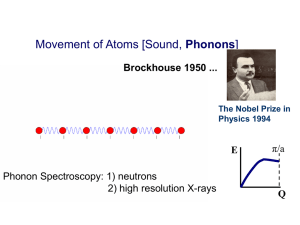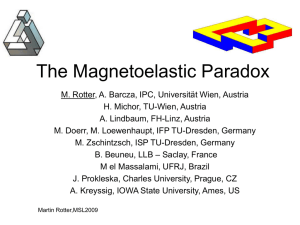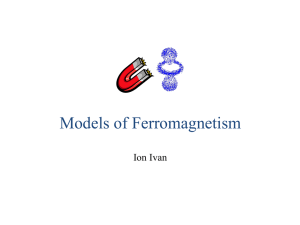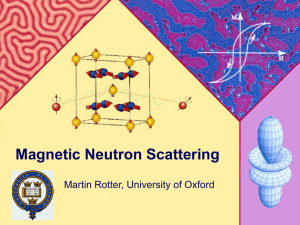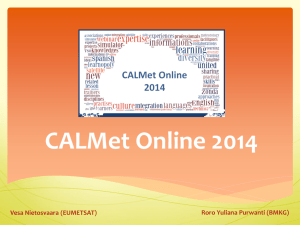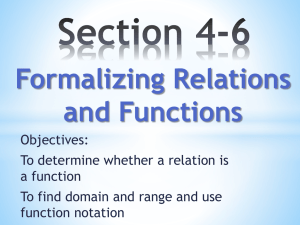Theory - Max-Planck-Institut Chemische Physik fester Stoffe
advertisement
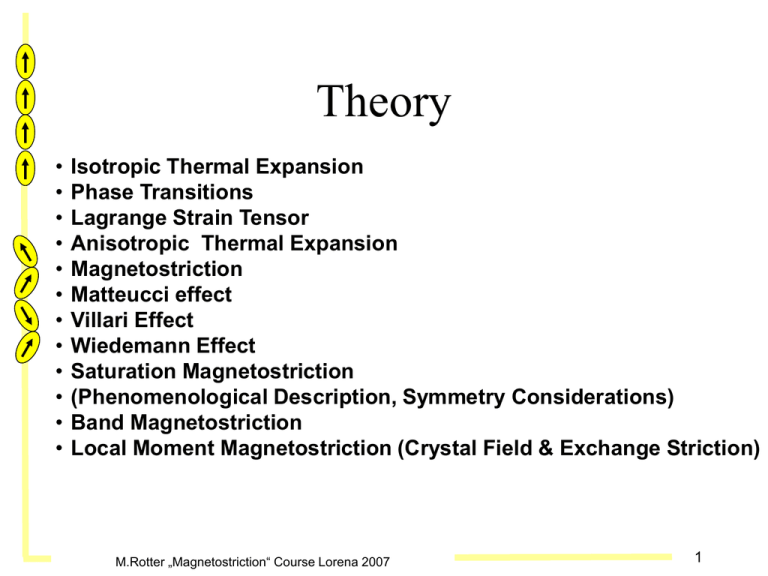
Theory
•
•
•
•
•
•
•
•
•
•
•
•
Isotropic Thermal Expansion
Phase Transitions
Lagrange Strain Tensor
Anisotropic Thermal Expansion
Magnetostriction
Matteucci effect
Villari Effect
Wiedemann Effect
Saturation Magnetostriction
(Phenomenological Description, Symmetry Considerations)
Band Magnetostriction
Local Moment Magnetostriction (Crystal Field & Exchange Striction)
M.Rotter „Magnetostriction“ Course Lorena 2007
1
Isotropic Thermal Expansion
Thermal expansion Coefficients
ln V T , P
T
P
ln V T , P PT ,V
PT ,V
T
P
T V
T V
T
Helmholtz free Energy dF SdT PdV
1 V T , P
1 F T ,V
T
V
P T V 2V
T
2
Compressibility
M.Rotter „Magnetostriction“ Course Lorena 2007
2
1
2 F T ,V
S T ,V
T
T
TV
V T
Approximation: compressibility is T independent
(dominated by electrostatic part of binding energy)
Sr T ,V
(T ) r T
V
r
r
T
Subsystem r ..... phonons, electrons,
magnetic moments
M.Rotter „Magnetostriction“ Course Lorena 2007
3
Phase
Transitions
M.Rotter „Magnetostriction“ Course Lorena 2007
4
x' x u ( x)
Mechanics of Solids Kinematics
i=1,2,3
Inf. Translation
Inf. Rotation
(antisymmetric matrix)
0
dx ' dx 3
2
3
0
1
Inf. Strain
(symmetric matrix)
2
1 dx
0
Volume Strain
M.Rotter „Magnetostriction“ Course Lorena 2007
5
Lagrange Strain Tensor
The strain tensor, ε, is a symmetric tensor used to quantify the strain of an object
undergoing a small 3-dimensional deformation:
• the diagonal coefficients εii are the relative change in length in the direction
of the i direction (along the xi-axis) ;
• the other terms εij = 1/2 γij (i ≠ j) are the shear strains, i.e. half the variation
of the right angle (assuming a small cube of matter before deformation).
The deformation of an object is defined by a tensor field, i.e., this strain tensor is
defined for every point of the object. In case of small deformations, the strain
tensor is the Green tensor or Cauchy's
infinitesimal strain tensor, defined by
the equation:
Where u represents the displacement field of the object's
configuration (i.e., the difference between the object's
configuration and its natural state). This is the 'symmetric
part' of the Jacobian matrix. The 'antisymmetric part' is
called the small rotation tensor.
M.Rotter „Magnetostriction“ Course Lorena 2007
6
T stress tensor
is defined by:
where the dFi are the components of the
resultant force vector acting on a small
area dA which can be represented by a
vector dAj perpendicular to the area
element, facing outwards and with
length equal to the area of the element.
In elementary mechanics, the subscripts
are often denoted x,y,z rather than 1,2,3.
Stress tensor is symmetric, otherwise the volume element would
rotate (to seet this look at zy and yz component in figure)
c
Hookes Law
(Voigt) notation
6
1
1 = 11, 2 = 22 3 = 33 4 = 23 5 = 31 6 = 12
M.Rotter „Magnetostriction“ Course Lorena 2007
7
Anisotropic Thermal Expansion
dF SdT V d
6
1
d
c
2 1
Elastic Energy density
1 F (T , )
.... strain can be written as
V
Thermal expansion Coefficients
Elastic Constants
Elastic Compliances
c
s
M.Rotter „Magnetostriction“ Course Lorena 2007
T ,
T
6
c
s
1
8
2
6
6
6
T
,
T
,
s
F
s
S
T
T
1
1 V T
1 V
.... this can (as in the isotropic case) be written as
sum of contributions of subsystems r = phonons,
electrons, magnetic moments
r
r
6
r T ,
s Sr
T
r
r 1 V
r
r
s Fr
V
r 1
6
M.Rotter „Magnetostriction“ Course Lorena 2007
T , 0
9
Grueneisens Approximation
S r
r r
cV
• Specific heat of subsystem r
• Grueneisen Parameter of
subsystem r ... Is in many
simple model cases
temperature independent
(T ) r
r
s r r
cV (T )
r 1 V
M.Rotter „Magnetostriction“ Course Lorena 2007
6
10
Normal thermal Expansion
Anharmonicity of
lattice dynamics
Y
C
u
2
1
.
0
0
0
0
.
9
9
9
a
anharmonic
Potential
0
.
9
9
8
Giterpametr,normiertauf30K
0
.
9
9
7
0
.
9
9
6
c
b
0
.
9
9
5
Harmonic
potential
+
Small
contribution of
band electrons
0 5
0 1
0
01
5
02
0
02
5
03
0
0
T
[
K
]
l
el phon K1T 2 K 2TD( D / T )
l
z
3 x 3dx
with Debye function D( z ) 3 x
z 0 e 1
Magnetostriction
Magnetostriction is a property of magnetic materials that
causes them to change their shape when subjected to a magnetic
field. The effect was first identified in 1842 by James Joule
when observing a sample of nickel.
James Prescott Joule, (1818 – 1889)
M.Rotter „Magnetostriction“ Course Lorena 2007
12
Thermal expansion Coefficients
Magnetostriction Coefficients
l T , H || e
H
T, H
l|| T , H || e
l T , H e
Material Crystal axis
T, H
T , H
T
T , H
H
Saturation magnetostriction
l|| (x 10-5)
Fe
100
Fe
111
Fe
polycristal
Terfenol-D 111
M.Rotter „Magnetostriction“ Course Lorena 2007
+(1.1-2.0)
-(1.3-2.0)
-0.8
200
13
Villari Effect
the change of the susceptibility of a material
when subjected to a mechanical stress
Matteucci effect
creation of a helical anisotropy of the
susceptibility of a magnetostrictive material
when subjected to a torque
Wiedemann Effect
twisting of materials when an helical magnetic
field is applied to them
M.Rotter „Magnetostriction“ Course Lorena 2007
14
Domain Effects
T>TC
T<TC M||111
rotation of the domains.
migration of domain walls within the material
in response to external magnetic fields.
M.Rotter „Magnetostriction“ Course Lorena 2007
15
In general the saturation magnetostriction will depend on the direction of the
field and the direction of measurement ... Taylor expansion in terms of cosines of
magnetization direction (αx αy αz) and measurement direction (βx βy βz)
(Cark Handbook of ferromagnetic materials, Elsivier, 1980)
l l x , y , z , x , y , z
Write Energy in terms of strain and Magnetization
F
b
M
1, 2,3
1,...,6
d
M
M
...
, 1, 2,3
1,...,6
Zero in case of
inversion symmetry
And apply
s F
l
V
1
6
+ consider symmetry
T , 0
Hexagonal
M.Rotter „Magnetostriction“ Course Lorena 2007
16
Cubic
(8 domains)
l l ( x y x y x z x z y z y z )l
Assumption: in zero field all 8 domains are equally populated
M.Rotter „Magnetostriction“ Course Lorena 2007
17
l lsingle domain111 in field laverageover 8 domainsin zerofield
111
||
dL/L Measurement dir. ( x , y , z ) ( 1 3 ,
1
3
,
1
3
)
magnetization
field
l l ( x y x y x z x z y z y z )l
Zero field
( x , y , z ) (
1
3
,
1
3
,
1
3
)
Field || 111
( x , y , z ) ( 1 3 ,
1
,
3
1
)
3
M.Rotter „Magnetostriction“ Course Lorena 2007
x y x z y z 0
... 8 domains
l
111
||
1
l
3
18
l laverageover 4 domainsin field laverageover 8 domainsin zerofield
100
||
( x , y , z ) (0,0,1)
dL/L Measurement dir.
magnetization
field
l l ( x y x y x z x z y z y z )l
is zero
l100
0
||
M.Rotter „Magnetostriction“ Course Lorena 2007
19
l
011
||
l2 domainsin field|| 011 laverageover 8 domainsin zerofield
dL/L Measurement dir. ( x , y , z ) (0, 1 2 , 1 2 )
magnetization
field
l l ( x y x y x z x z y z y z )l
Zero field
( x , y , z ) (
1
3
,
1
3
,
1
3
)
... 8 domains – contributions cancel
Field || 011
( x , y , z ) ( 1 3 ,
1
,
3
1
), (
3
1
,
3
M.Rotter „Magnetostriction“ Course Lorena 2007
1
,
3
1
)
3
l
011
||
1
l
6
20
l
011
l
011
H ||011
l2 domainsin field|| 0-11 laverageover 8 domainsin zerofield
( x , y , z ) (0, 1 2 , 1 2 )
dL/L Measurement dir.
magnetization
field
l l ( x y x y x z x z y z y z )l
Zero field
( x , y , z ) (
1
3
,
1
3
,
1
3
)
... 8 domains – contributions cancel
Field || 0-11
( x , y , z ) ( 1 3 ,
1
,
3
1
), (
3
1
,
3
M.Rotter „Magnetostriction“ Course Lorena 2007
1
,
3
1
)
3
l
011
1
l
6
21
Summary
Cubic crystal, easy axis 111
Assumption: in zero field all 8 domains are equally populated
Magnetostriction due to domain rotation is given by
111
||
l
1
l
3
011
||
l
1
l
6
l
011
||
l100
0
||
l
011
l
011
M.Rotter „Magnetostriction“ Course Lorena 2007
1
l
6
1 111
l||
2
22
Atomic Theory of Magnetostriction
• Band Models
• Localized Magnetic Moments
M.Rotter „Magnetostriction“ Course Lorena 2007
23
Magnetism of Free Electrons
Sommerfeld Model of Free Electrons
Schrödinger equation
Free electrons (positive energy)
Schrödinger equation of
free electrons
Solution
Characteristic equation
Momentum
Wavevector k
M.Rotter „Magnetostriction“ Course Lorena 2007
24
Periodic Boundary Condition (1d):
Complex numbers
Condition for phases
Allowed k-vectors (3 dim)
Possible wavefunctions (3 dim)
M.Rotter „Magnetostriction“ Course Lorena 2007
25
2-D projection
of 3-D k-space
• Each state can hold 2 electrons
of opposite spin (Pauli’s principle)
ky
• To hold N electrons
dk
4pk 3 k
N 2
3
F
k
2p/L
kx
2p L3
k F 3p he
2
3
F
V
2
3p
1
3
kF: Fermi wave vector
he=N/V: electron number density
2 k F2 2
Fermi Energy EF
3p 2he
2m
2m
1
k
2
Fermi Velocity: vF F
3p he 3
m
m
E
Fermi Temp.
TF F
kB
M.Rotter „Magnetostriction“ Course Lorena 2007
26
2
3
Fermi Parameters for some Metals
F: Work Function
Vacuum
Level
Energy
EF
free
electrons
electrons in
periodic potential
–energy gap at
Brillouin zone
boundary
Band Edge
Element Electron
Density, he
28 -3
[10 m ]
Na
2.65
Cu
8.47
Ag
5.86
Au
5.90
Fe
17.0
Al
18.1
Sn
14.8
Fermi
Energy
EF [eV]
3.24
7.00
5.49
5.53
11.1
11.7
10.2
Fermi
Temperature
4
TF [10 K]
3.77
8.16
6.38
6.42
13.0
13.6
11.8
M.Rotter „Magnetostriction“ Course Lorena 2007
Fermi
Wavelength
lF [Å]
6.85
4.65
5.22
5.22
2.67
3.59
3.83
Fermi
Velocity
6
vF [10 m/s]
1.07
1.57
1.39
1.40
1.98
2.03
1.9
Work
Function
F [eV]
2.35
4.44
4.3
4.3
4.31
4.25
4.38
27
Effect of Temperature
Fermi-Dirac equilibrium
distribution for the
probability of electron
occupation of energy
level E at temperature T
Occupation Probability, f
Enrico
Fermi
kBT
1
0
T=0K
1
f E
E
1 exp
k BT
Electron Energy, E
M.Rotter „Magnetostriction“ Course Lorena 2007
Vacuum
Energy
Increasing T
μ
Work Function, F
28
Number and Energy Densities
Summation
over k-states
Integration
over k-states
N 2
f E k ;
k k F
N
Transformation from
k to E variable
Integration of
E-levels for
number and energy
densities
kF
2
L
2p
3
Ee 2
k k F
4pk f E k dk;
2
2k 2
f E k
2m
Ee
0
kF
2
L
2p
3
0
2k 2
f E k 4pk 2 dk
2m
2k 2
2m E
1 m
E
; k
; dk
dE
2m
2E
E
N
he f E De E dE; e e Ef E De E dE
V 0
V
0
Density of StatesDe E
A tedious calculation gives:
m
2p 2
2mE 3 he
2
2 EF
Number of k-states available
between energy E and E+dE
p 2 k T 2
k T 4
EF 1 B O B
EF
12 EF
M.Rotter „Magnetostriction“ Course Lorena 2007
29
Free Electrons in a Magnetic Field
Pauli Paramagnetism
Spin - Magnetization
for small fields B (T=0)
M B n n De EF B B
2
Magnetic Spin - Susceptibility
M 0 M
2
P
0 B De EF
H
B
2
3he 0 B
(Pauli Paramagnetism)
2 EF
The small size of the paramagnetic
susceptibility of most metals was a
puzzle until Pauli pointed out that is
was a consequence of the fact that
electrons obey Fermi Dirac rather
than classical statistics.
W. Pauli
„Magnetostriction“ Course Lorena 2007
Nobel M.Rotter
Price 1945
Pauli paramagnetism is a weak effect
compared to paramagnetism in
insulators (in insulators one electron at
each ion contributes, in metals only the
electrons at the Fermi level contribute).
30
Direct Exchange between delocalized Electrons
Spontaneously Split bands: e.g. Fe M=2.2μB/f.u. is non integer
.... this is strong evidence for band ferromagnetism
Mean field Model: all spins feel the same exchange field λM
produced by all their neighbors, this exchange field can
magnetize the electron gas spontaneously via the Pauli
Paramagnetism, if λ and χP are large anough.
Quantitative estimation: what is the condition that the system
as a whole can save energy by becoming ferromagnetic ?
moving De(EF)δE/2 electrons from spin down to spin up band
kinetic energy change: EK .E . De ( EF )E 2
1
2
exchange energy change:
M
1
1
EP.E . 0 lM 'dM ' 0lM 2 0l B2 (n n ) 2
2
2
0
M.Rotter „Magnetostriction“ Course Lorena 2007
31
total energy change:
U 0 B2 l
n n De ( EF )E
1
2
E EK .E . EP.E . De ( EF )E 1 UDe ( EF )
2
there is an energy gain by spontaneous magnetization, if
UDe ( EF ) 1
... Coulomb Effects must be
strong and density of states at
the Fermi energy must be large
in order to get sponatneous
ferrmagnetism in metals.
M.Rotter „Magnetostriction“ Course Lorena 2007
Stoner Criterion
Edmund C.
Stoner
(1899-1968)
32
Spontaneous Ferromagnetism splits the spin up and spin
down bands by Δ
If the Stoner criterion is not fulfilled, the susceptibility of
the electron gas may still be enhanced by the exchange
interactions:
1
2
E De ( EF )E 1 UDe ( EF ) MB
2
M2
1 UDe ( EF ) MB
2
2 B De ( EF )
this is minimized when
energy change in
magnetic field
M
1 UDe ( EF ) B 0
2
B De ( EF )
M 0 M 0 B2 De ( EF )
P
H
B
1 UDe ( EF ) 1 UDe ( EF )
M.Rotter „Magnetostriction“ Course Lorena 2007
33
Band Magnetostriction
moving De(EF)δE/2 electrons from spin down to spin up band
exchange energy change:
M
1
EP.E . 0 lM 'dM ' 0lM 2
2
0
kinetic energy change:
V
F
T
M2
V
V
M.Rotter „Magnetostriction“ Course Lorena 2007
34
Gd metal
Tc= 295 K ,
TSR= 232 K
M||[001]=7.55B
LARGE VOLUME
MAGNETOSTRICTION !
...anisotropic MS
c/a(T) not explained
M.Rotter „Magnetostriction“ Course Lorena 2007
35
Mechanisms of magnetostriction in the
Standard model of Rare Earth Magnetism
microscopic origin of magnetostriction =
strain dependence of magnetic interactions
1) Single ion effects
Crystal Field Striction
…spontaneous
magnetostriction
…forced
magnetostriction
M.Rotter „Magnetostriction“ Course Lorena 2007
T >TN
kT >>cf
kT <cf
T <TN
T <TN
H
36
T >TN
M.Rotter „Magnetostriction“ Course Lorena 2007
kT >>cf
kT <cf
37
T <TN
NdCu2
TN
TN
M.Rotter „Magnetostriction“ Course Lorena 2007
38
T <TN
NdCu2
M.Rotter „Magnetostriction“ Course Lorena 2007
T <TN
H
39
2) Two ion effects
Exchange Striction
T >TN
…spontaneous
magnetostriction
T <TN
…forced
magnetostriction
T <TN
M.Rotter „Magnetostriction“ Course Lorena 2007
H
40
GdCu2 (Gd3+ shows no CEF effect... only exchange striction)
Forced Magnetostriction
Spontaneous Magnetostriction
TN
T=4.2K
M. Rotter, J. Magn. Mag. Mat. 236 (2001) 267-271
M.Rotter „Magnetostriction“ Course Lorena 2007
41
Calculation of Magnetostriction
Crystal field
Exchange
1
H ex J (ij, )J i J j
2 ij
H cf Blm ( )Olm (J i )
i ,lm
H Eel Hcf ( 0) H ex ( 0)
with Eel
Z Tr{e
H / k BT
1
2
c
}
F k BT ln Z
l Olm (J) T ,H
B m
lm
M.Rotter „Magnetostriction“ Course Lorena 2007
k
+
( H cf H ex )
...
F
0
J i J i k T , H
J (i, i k )
42
NdCu2 Magnetostriction
Crystal Field
H H cf ( 0)
H cf
H ex ( 0)
Exchange - Striction
H ex
Calculation done by Mcphase
www.mcphase.de
M.Rotter „Magnetostriction“ Course Lorena 2007
43
How to start – the story of NdCu2
• Suszeptibility: 1/χ(T) at high T
... Crystal Field Parameters B20, B22
• Specific Heat Cp
... first info about CF levels
• Magnetisation || a,b,c on single crystals in the paramagnetic state,
... ground state matrix elements
• Neutron TOF spectroscopy – CF levels
... All Crystal Field Parameters Blm
• Thermal expansion in paramagnetic state – CF influence
... Magnetoelastic parameters (dBlm/dε)
• Neutron diffraction: magnetic structure in fields || easy axis
... phase diagram H||b - model
... Jbb
• Neutron spectroscopy on single crystals in H||b=3T
... Anisotropy of Jij - determination of Jaa=Jcc
• Magnetostriction
... „Magnetostriction“
Confirmation
ofLorena
phase
44
M.Rotter
Course
2007diagram models H||a,b,c, dJ(ij)/dε
The story of NdCu2
1
(2 J 1)( 2 J 3) 0
J ( J 1) J (q 0)
( B2 B22 )
3
10
1
(2 J 1)( 2 J 3) 0
kb J ( J 1) J (q 0)
B2
3
5
1
(2 J 1)( 2 J 3) 0
k c J ( J 1) J (q 0)
( B2 B22 )
3
10
k a
• Inverse suszeptibility at
high T
... B20=0.8 K, B22=1.1 K
Hashimoto, Journal of Science of the
Hiroshima University A43, 157 (1979)
Θabc
M.Rotter „Magnetostriction“ Course Lorena 2007
45
The story of NdCu2
Specific haet Cp and entropy – first info about levels
Gratz et. al., J. Phys.: Cond. Mat. 3 (1991) 9297
Rln2
M.Rotter „Magnetostriction“ Course Lorena 2007
46
How to start analysis – the story
of NdCu2
• Magnetization: Kramers ground state doublet |+-> matrix elements
M g B tanh( g B ( H lM ) /( 2kT ))
a, b, c
P. Svoboda et al. JMMM 104 (1992) 1329
g a / g J J y 2.1
g b / g J J z 2.8
g c / g J J x 1.5
M.Rotter „Magnetostriction“ Course Lorena 2007
47
How to start analysis – the story
of NdCu2
• Neutron TOF spectroscopy – CF levels
Gratz et. al., J. Phys.: Cond. Mat. 3 (1991) 9297
... Blm
B20=1.35 K
B22=1.56 K
B40=0.0223 K
B42=0.0101 K
B44=0.0196 K
B60=4.89x10-4 K
B62=1.35x10-4 K
B64=4.89x10-4 K
B66=4.25 x10-3 K
M.Rotter „Magnetostriction“ Course Lorena 2007
48
The story of NdCu2
• Thermal expansion – cf influence
... Magnetoelastic parameters (A=dB20/dε, B=dB22/dε)
E. Gratz et al., J. Phys.: Condens. Matter 5, 567 (1993)
M.Rotter „Magnetostriction“ Course Lorena 2007
49
The story of NdCu2
• Neutron diffraction+ magnetization:
magstruc, phasediag H||b-> model
... Jbb
M. Loewenhaupt et al., Z. Phys. B:
Condens. Matter 101, 499 (1996)
n(k)=sum of Jbb(ij) with ij being of bc plane k
f(B) [arb.units] T=0K
BcAF1F3
B
AF1
Bc1
Bc2
Bc3
F1
F2
F3
NdCu2 Magnetic Phase Diagram
F1
F3
c
F1
a
b
AF1
lines=experiment
M.Rotter „Magnetostriction“ Course Lorena 2007
51
The story of NdCu
Jaa=Jcc(R)
2
• Neutron spectroscopy on single crystals in H||b=3T
... Anisotropy of J(ij) - determination of Jaa=Jcc
F3
M. Rotter et al., Eur. Phys. J. B 14, 29 (2000)
M.Rotter „Magnetostriction“ Course Lorena 2007
52
F3
NdCu2
F1
AF1
M. Rotter, et al. Applied Phys. A 74 (2002) s751
How to start analysis – the story
of NdCu2
• Magnetostriction ... Confirmation of phasediagram model for H||a,b,c, and
determination of dJ(ij)/dε
M. Rotter, et al. J. of Appl. Physics 91 10(2002) 8885
M.Rotter „Magnetostriction“ Course Lorena 2007
55
McPhase - the World of Rare Earth Magnetism
McPhase is a program package for the calculation of
magnetic properties of rare earth based systems.
Magnetization
Magnetic Phasediagrams
Magnetic Structures
M.Rotter „Magnetostriction“ Course Lorena 2007
Elastic/Inelastic/Diffuse
Neutron Scattering
Cross Section
56
Crystal Field/Magnetic/Orbital Excitations
Magnetostriction
and much more....
M.Rotter „Magnetostriction“ Course Lorena 2007
57
Epilog
McPhase runs on Linux and Windows and is available as freeware.
www.mcphase.de
McPhase is being developed by
M. Rotter, Institut für Physikalische Chemie, Universität Wien, Austria
M. Doerr, R. Schedler, Institut für Festkörperphysik,
Technische Universität Dresden, Germany
P. Fabi né Hoffmann, Forschungszentrum Jülich, Germany
S. Rotter, Wien, Austria
M.Banks, Max Planck Institute Stuttgart, Germany
Important Publications referencing McPhase:
• M. Rotter, S. Kramp, M. Loewenhaupt, E. Gratz, W. Schmidt, N. M. Pyka, B.
Hennion, R. v.d.Kamp Magnetic Excitations in the antiferromagnetic phase of
NdCu2 Appl. Phys. A74 (2002) S751
• M. Rotter, M. Doerr, M. Loewenhaupt, P. Svoboda, Modeling Magnetostriction
in RCu2 Compounds using McPhase J. of Applied Physics 91 (2002) 8885
• M. Rotter Using McPhase to calculate Magnetic Phase Diagrams of Rare Earth
Compounds J. Magn. Magn. Mat. 272-276 (2004) 481
M.Rotter „Magnetostriction“ Course Lorena 2007
58
